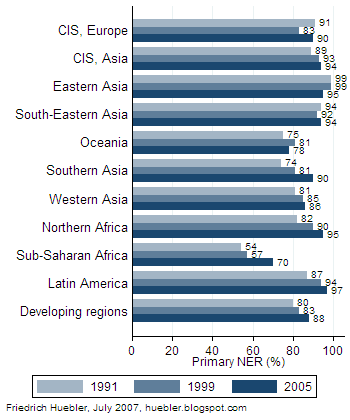 In June 2007, the United Nations published the latest edition of its annual report on progress toward the Millennium Development Goals (MDG). The Millennium Development Goals Report 2007 presents data for each of the eight MDGs.
In June 2007, the United Nations published the latest edition of its annual report on progress toward the Millennium Development Goals (MDG). The Millennium Development Goals Report 2007 presents data for each of the eight MDGs.- Eradicate extreme poverty and hunger
- Achieve universal primary education
- Promote gender equality and empower women
- Reduce child mortality
- Improve maternal health
- Combat HIV/AIDS, malaria and other diseases
- Ensure environmental sustainability
- Develop a global partnership for development
Primary school net enrollment rate, 1991-2005

Source: United Nations, The Millennium Development Goals Report 2007, page 10.
Seven regions have reached primary school net enrollment rates at or above 90 percent: Commonwealth of Independent States (Europe and Asia), Eastern Asia, South-Eastern Asia, Southern Asia, Western Asia, Northern Africa, and Latin America. Western Asia is slightly behind with a primary NER of 86 percent, followed by Oceania at 78 percent.
Sub-Saharan Africa has made the most progress over the past years, with a 13 percent increase in the primary NER from 57 percent in 1999 to 70 percent in 2005. Still, three out of ten children of primary school age in Sub-Saharan Africa are not enrolled in primary school. In all developing regions combined, the primary NER rose from 80 percent in 1991 to 88 percent in 2005.
Related articles
- Global trends in primary and secondary education, 2000-2004
- Trends in primary school enrollment, 1970-2004
- Millennium Development Goal regions and UNICEF regions
- UN Millennium Development Goals Report 2008
Friedrich Huebler, 29 July 2007 (edited 17 October 2008), Creative Commons License
Permanent URL: http://huebler.blogspot.com/2007/07/un-millennium-development-goals-report.html
No comments:
Post a Comment